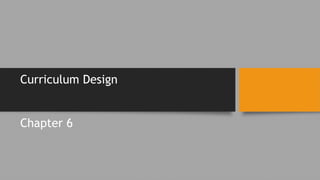
Chapter 6 curriculum design
- 2. The Purpose of Education • Educators have various views about the purpose of education. Some, like Ron Ritchhart, believe education is meant to create intelligence. Kieran Egan says that most educators focus on education and its design for the idea of socialization, academics, and development. Were these ideas to operate separately, the result would be one sided and insufficient. However these ideas working together have helped educators before our time determine how education should be.
- 3. Parts of Curriculum Design • The parts of the curriculum design should help the entire curriculum progress. Philosophical and theoretical ideas should be aligned with beliefs about what people learn, how they learn, and how they should use the knowledge gained. • The interests of curriculum design are the objectives, content, learning experiences, and the evaluation. There should be a relationship with the basic parts of the design. Philosophy determines what objectives are chosen and how they are chosen, what content is taught, how the content is organized, how to teach the curriculum, and how to evaluate the curriculum.
- 4. 4 Sources of Curriculum Design • Science- relies on the scientific method; has data that can be observed and measured; emphasizes learning how to learn • Society- school has a role in society and should draw its curriculum ideas based on social situations; serves community interests; current and future society concerns are at the forefront when making decisions; works with social and political communities • Moral doctrine- rely on beliefs of philosophers of the past; focus on content in which is more important; guided by religion or spirituality; encourages consciousness, attentiveness, awareness of the outside world, and self awareness; concerned about the meaning of life • Knowledge- is the main source of curriculum; references Plato's
- 5. Additional Source • Learner- knowledge comes from how students learn, what attitudes students form, what interests are created, what values are developed; relies on how the mind creates meanings • Learner knowledge is based on Rousseau's theory of development of the mind.
- 6. Conceptual Framework • Curriculum designed is organized in two ways: horizontal and vertical. Horizontal organization combines the fundamentals of curriculum. Vertical organization puts the curriculum in a specific order. Curriculum may be organized where one topic may be taught in different grade levels, but the difficulty increases as the grade level does. Horizontal and vertical organizations are determined by the socio-economic, political, and cultural factors.
- 7. Design Dimensions • When designing a curriculum, specialist should make sure that curricula should have experiences that engage students, months of units, information of what will be taught and how the content will be taught. It should determine how content and experiences should progress based on brain development. The curriculum should be sequenced by one of the following ways of learning: easy to difficult, part to whole, the big idea broken down into pieces, or chronologically by real world events. The curriculum should repeat the same kinds of skills. It should link all kinds of knowledge and experiences.
- 8. 3 Basic Curriculum Designs • Most curriculum designs are based off of the following: • subject-centered • learner-centered • problem-centered
- 9. Subject-Centered Design • Knowledge and content are major parts of the curriculum • The design follows Plato's academic idea. • Under the subject-centered design include subject designs, discipline designs, broad field designs, correlation designs, and process designs.
- 10. Learner-Centered Design • This design is more prominent if the elementary schools. The whole child is the focus. • In the secondary schools, subject-centered design is more important because students have to focus more on the content of the textbook. • Learner-centered designs stress the development of the mind and socialization. • Learner-centered designs are child-centered designs, experience- centered designs, romantic/radical designs, and humanistic designs.
- 11. Problem-Centered Designs • Problem-centered design is based on real-life problems of individuals and society. They are meant to reinforce traditions and address needs that haven't been fulfilled in the community and society. • These designs think about life situations, core designs, or social problem/reconstructionist designs.
- 12. Reference List • Ornstein, A. & Hunkins, F. (2013) Curriculum, foundations, principles, and issues. (6th ed.). United States of America: Pearson Education .